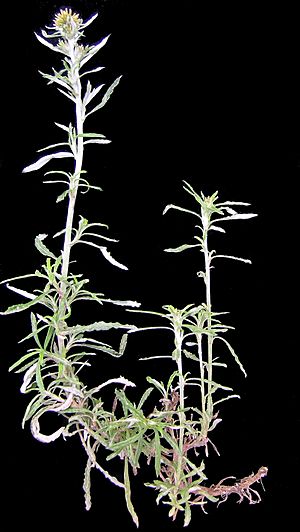Common cudweed facts for kids
Quick facts for kids Common cudweed |
|
|---|---|
 |
|
| Scientific classification | |
| Kingdom: | |
| (unranked): | |
| (unranked): | |
| (unranked): | |
| Order: | |
| Family: | |
| Genus: |
Euchiton
|
| Species: |
E. involucratus
|
| Binomial name | |
| Euchiton involucratus (G.Forst.) Holub 1974
|
|
Euchiton involucratus, also known as common cudweed, is a type of herb. It belongs to the pussy's-toes tribe, which is part of the large sunflower family. This plant naturally grows in Australia and New Zealand. You can also find it in a few places in the United States, like California and Massachusetts, where it has spread and grown on its own.
What is Common Cudweed?
Common cudweed is a plant that can live for two years (biennial) or even longer (perennial). It usually grows up to 40 centimeters (about 16 inches) tall. This plant spreads out by sending special stems called stolons along the ground. These stolons help new plants grow nearby.
How to Identify Common Cudweed
The stems of the common cudweed are usually straight and do not have many branches. They are covered with soft, white, woolly hairs, which makes them look fuzzy.
Leaves and Flowers
The leaves of this plant are long and narrow, shaped like a spear. The top side of the leaves is green and looks a bit shiny. The underside, however, is white and also covered in those soft, woolly hairs.
The plant produces its flowers in round clusters at the very top of the plant. Sometimes, you might see smaller flower clusters growing where the leaves meet the stem. Each flower cluster is shaped like a cylinder. It has brown or copper-colored leaf-like parts called bracts on the outside. Inside each cluster, there are many tiny flowers. There are usually 80 to 150 female flowers around the edge. In the center, there are 3 to 7 flowers that have both male and female parts.

